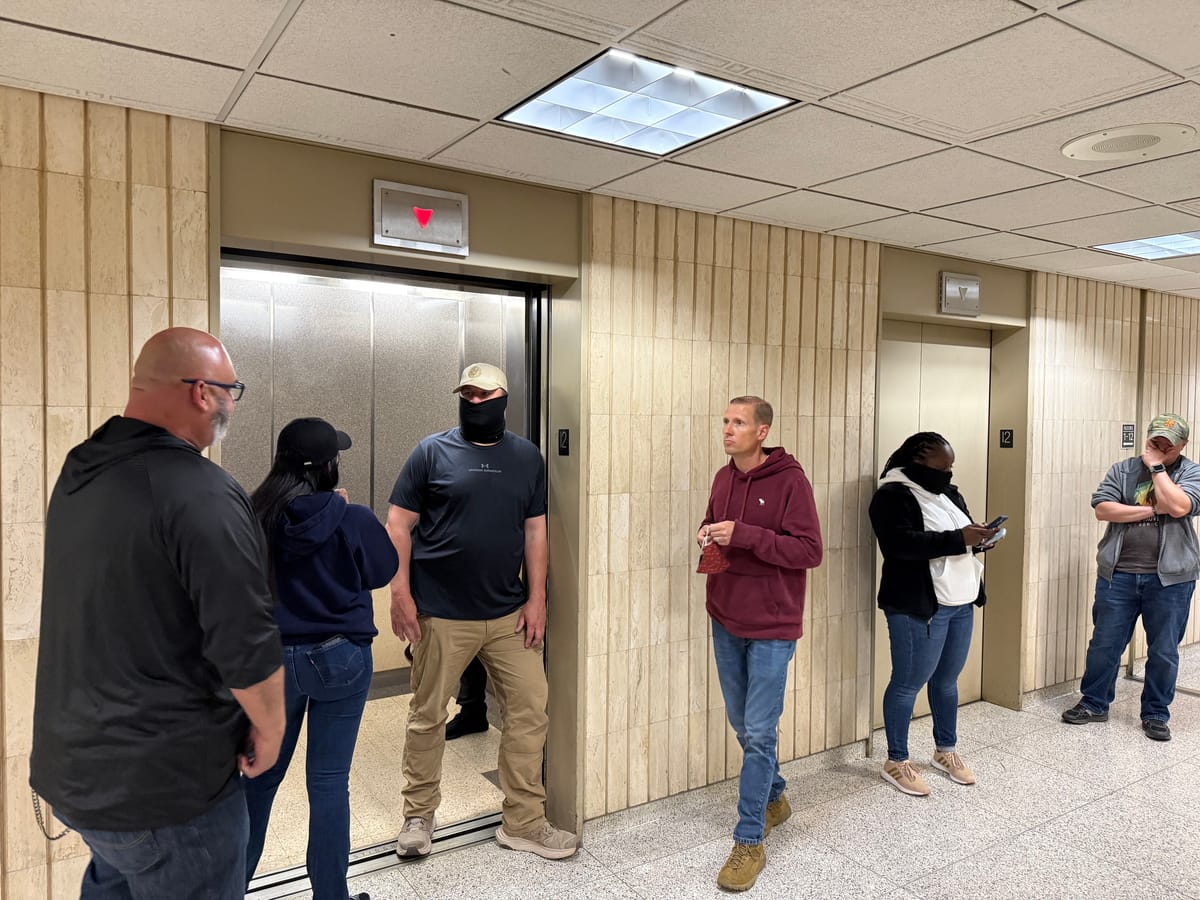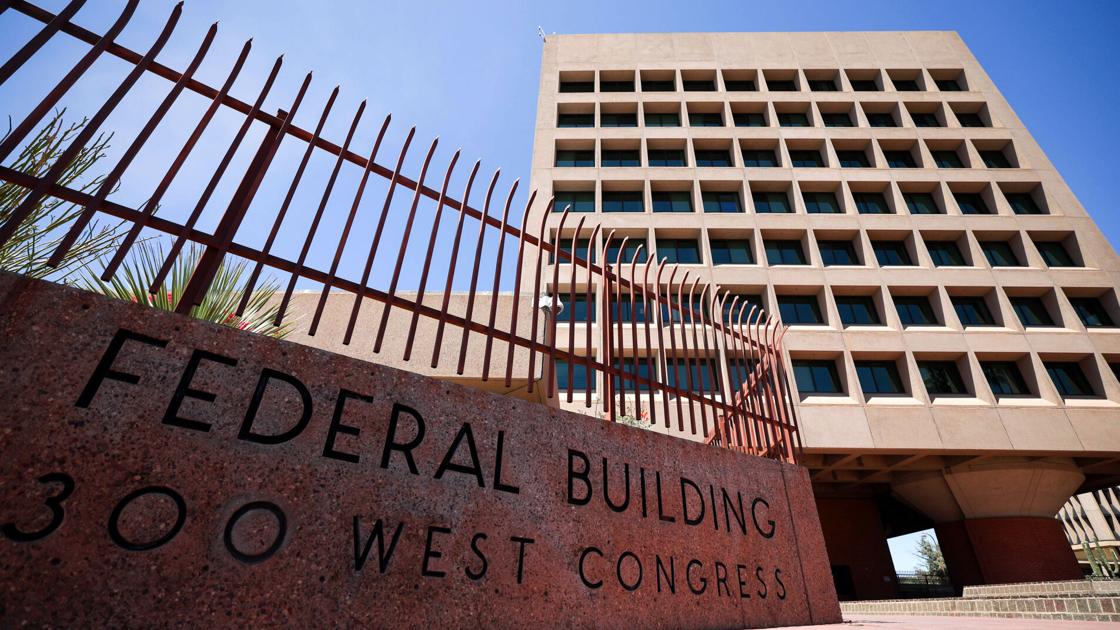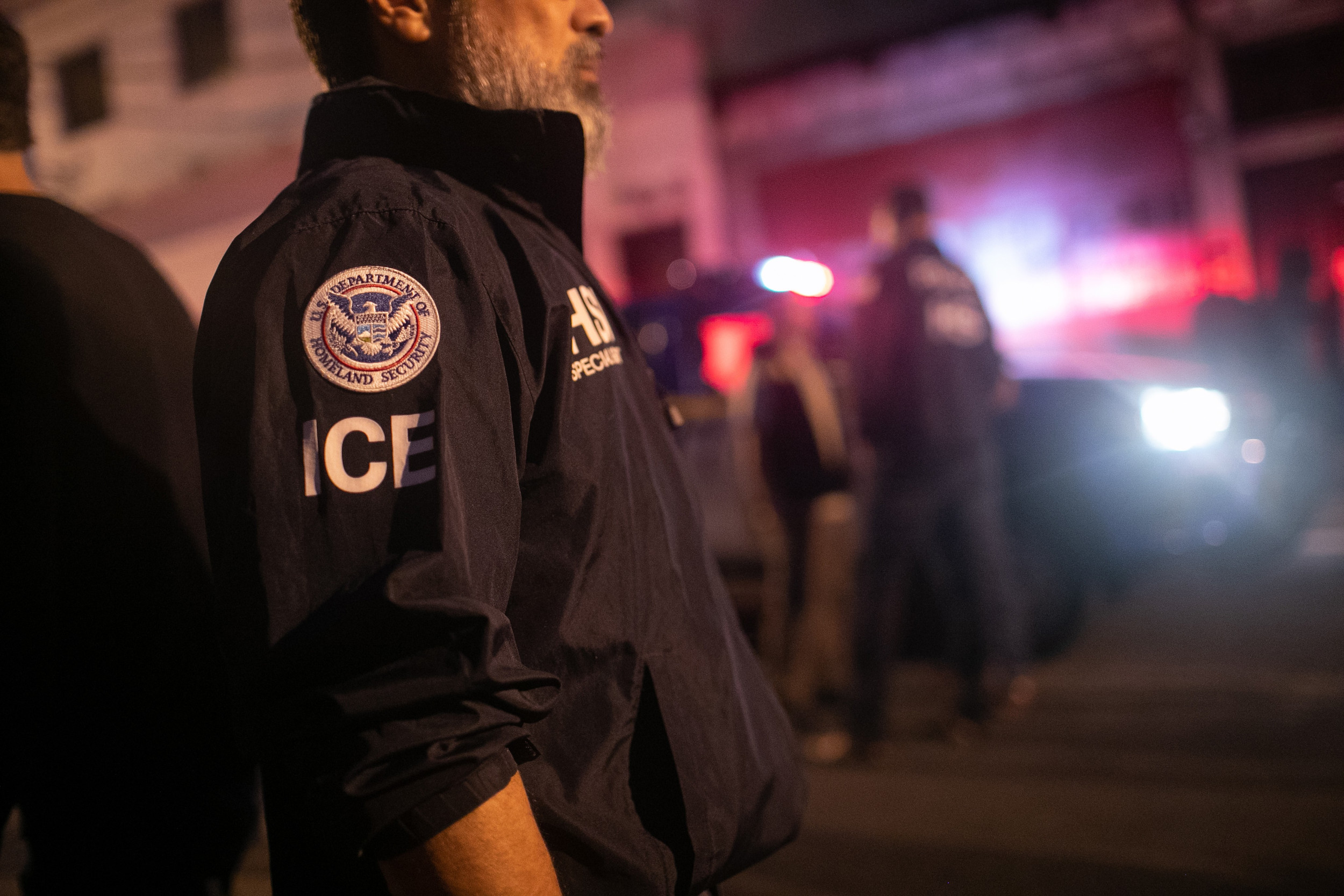
Outside of the elevator on the twelfth floor of 26 Federal Plaza on Friday afternoon, several Immigration and Customs Enforcement officers were milling about, some with neck gaiters or face masks on, and others standing, unmasked, absentmindedly looking at their phones. When one officer realized I was taking photos of them, they told another one who was unmasked, “Hey, mask up, you’re being filmed.” On the other side of the hallway, other ICE agents were handcuffing an immigrant who had been pushed up against the wall.
ICE agents have been stationed in New York City’s three immigration courthouses in Lower Manhattan (at 290 Broadway, 26 Federal Plaza, and 201 Varick Street) for much of the past two weeks, arresting dozens of immigrants who have shown up for routine hearings for their immigration cases as part of the Trump administration’s targeting of asylum seekers.
This operation has relied on two major changes to immigration policy—one change is the expansion of a congressional statute called “expedited removal,” which allows for fast-tracked deportations. Previously, it was only used against people who had entered the country within two weeks—now, it’s been expanded to apply to people who have been here for less than two years. The other change is a reversal of a Biden-era policy that prohibited ICE agents from making arrests at “sensitive locations,” like schools, hospitals, churches, and courthouses.
With these two changes in place, Department of Homeland Security prosecutors are now coordinating with ICE to set a trap for immigrants—they’re moving to dismiss people’s removal cases, in order to then arrest them and attempt to deport them through “expedited removal.”
On Friday, after the ICE agents got into an elevator and left with the immigrant they’d arrested, a private security guard motioned me over.
“Do you think these people sleep well at night?” the private security guard asked about the masked men. I said I was certain they did. The private security guards recounted people crying, screaming, and pleading for help during the past week as they were being led away by the ICE agents.
Last week, New Yorkers attempted to stop ICE vans from leaving one of the courthouses, before they themselves were arrested by the NYPD.
Rachel Levenson, an attorney for the immigrant rights group Make the Road New York, was in immigration court last week. “As a practitioner, I’m moving through this with disbelief and shock,” she told me. “This is so extreme, from both a legal perspective and one’s conscience.”
In an interview conducted on Saturday, she spoke about what she saw last week; why every available immigration attorney should flood courtrooms when court resumes this Monday; and why New Yorkers, through the sheer act of just being present in a public courthouse, can help fellow New Yorkers avoid being disappeared by ICE.
This interview has been lightly edited and condensed for clarity.
Hell Gate: What are these hearings that immigrants are showing up to in Lower Manhattan?
Rachel Levenson: The people going to hearings at New York City’s three immigration court buildings are in removal proceedings. That means they’re appearing before an immigration judge and pursuing defenses against their removal. Some are green-card holders, some are asylum seekers, others may be seeking other protections from removal. It’s the basic process the government puts the majority of people it’s trying to remove from the United States through. And that involves appearing before an immigration judge.
People must appear at these court hearings. Failure to appear would result in a removal order against them. Once you have one of those, the government could immediately deport you at any moment.
When did you start hearing that DHS lawyers were moving to close these removal cases, and coordinating with ICE to arrest people at these hearings?
We heard whispers something like this might happen, and it was so outrageous, we couldn’t believe they would go through with it, but we first started seeing this in New York City last week.
We knew it was possible because one of the first things Trump did when he got back in office was to expand expedited removal. But ICE can’t use that process if you’re in active removal proceedings—and that’s according to the congressional statute for expedited removal. So what we’re seeing is a two-step process—ending the proceedings in court, and then immediately arresting and putting people in expedited removal.
People appearing in court think that something good is happening when they hear that the government is moving to dismiss their cases. They’re told by a judge that their removal proceedings are being dismissed. People understand that these proceedings are meant to ultimately deport them, so it’s good to have them dismissed.
But this move to then put them in expedited removal is unprecedented. We’ve never seen this before. This is irreversible harm to people and their immigration cases.
What did you see in immigration court yourself last week?
In just two days, Make the Road NY has tracked 50 people who had their cases dismissed, the majority of whom were then arrested by ICE agents either in the hallway outside the courtroom, the lobby of the building, or, in some cases, even in the courtroom itself. People are being forced to choose between being disappeared by ICE agents at court, or, if they don’t show up, having a removal order placed on them anyway.
People are being disappeared once they’re arrested by ICE. I’ve been trying to get in touch with several people I spoke to in court last week, who I’ve been unable to locate or speak with. That’s terrifying.
When I was in court on Thursday at 26 Federal Plaza, I spoke with an immigrant in the elevator who had a court notice in their hand. I asked if they’ve been here under two years—they said yes. This was the exact type of person the government would be seeking to dismiss their charges and then arrest.
I’m thinking, “What was this guy supposed to do?” And the elevator doors opened and the first thing I see are two people being handcuffed and being pushed into an elevator by plainclothes ICE officers. I’ve never seen that as an immigration attorney ever before. One of them told me he was 19 years old.
As a practitioner, I’m moving through this with disbelief and shock. This is so extreme, from both a legal perspective and one’s conscience.
What should people with immigration court hearings coming up be doing?
That’s so difficult, because for as long as I’ve practiced, we’ve told people to go to their immigration court hearings. We always tell people, “You should never skip court because you’re scared, the consequences are so severe if you don’t show up.”
What we saw is what people always feared would happen and what I’ve reassured people was not happening in practice, and that I never heard of before. It’s now happening.
As an immigration attorney, how have you been able to help people avoid being arrested by ICE in these courthouse traps?
What makes a crucial difference in these cases is immigrants knowing that they can object, they can ask for clarification, they can ask for more time—and the courts also knowing that and hearing the importance of that. I think that helping people to assert their right to oppose DHS’s motion, asking that the motion be in writing, and asking for more time, all have had a direct impact on whether a person is detained.
These motions are confusing. It is very hard to object effectively on the spot. People need more time and an opportunity to consult with counsel. I saw the direct impact of that when I was in court last week.
Even if people are not able to get more time, or even if ICE detains them anyway, an attorney can tell them what is happening and give them warning. I was able to tell people, you need to call someone and give them what might be your last goodbye for some time—ICE is right there in the hallway. I’ve seen people have panic attacks at this moment.
Fortunately nearly everyone I was able to speak with last week was able to walk out of the courthouse, but even with a judge keeping the case open, ICE will sometimes just arrest some people anyways.
Can you share an example of the latter?
At Varick Street on Thursday, Judge Lucy Billings told prosecutors that she would need them to file the motion in writing and wasn’t willing to entertain an oral motion, which obviously would put immigrants, the majority of whom who don’t have lawyers, at a serious disadvantage.
The hallways outside the courtroom were absolutely lined with ICE agents. And immigrants were scared to leave, even though their cases were still open. What happened was that ICE agents then stormed into the courtroom, kicked out the attorneys, and detained everyone in the courtroom over the judge’s objections. Really terrifying.
How many other attorneys were doing the work you were doing last week? The vast majority of people in court were still unrepresented and unassisted by a lawyer, right? Should lawyers be flooding these courts?
When I would have to go out into the hallway to speak privately with someone I was assisting, the judge and the DHS prosecutors would keep the docket moving, and would be granting motions to dismiss for somebody else when I wasn’t there.
We need more immigration attorneys there to, at a minimum, witness what’s happening anddocument what’s happening, and at best, step in to prevent these dismissal motions from being granted without the unrepresented people having a true opportunity to respond.
We also need volunteers to be there to just walk people from court safely out of the building. ICE agents have been deterred from making arrests if there’s somebody else there, I’ve seen this happen. You have a right as a citizen to be in that building. It’s a public space, and the more eyes that are on this, it can slow this down in some fashion.
And what’s the longer-term solution here? Can ICE just keep doing this forever?
Right now, our hope is that federal courts will soon intervene. Make the Road is a plaintiff in a case challenging expedited removal’s nationwide expansion, which would put a stop to this. But it’s hard to say what the federal courts will decide and when that will happen.
So right now, it’s all hands on deck for immigration attorneys to do what they can to protect the rights of unrepresented individuals and to address the harm already caused. We need to find these people who have been disappeared and help them stop their impending removal.



